Troubleshooting
Question mark in prompt
If it looks like a regular ?, that's normal. It means you have untracked files in the current Git
repository. Type git status to see these files. You can change this symbol or disable the display
of untracked files altogether. Search for untracked files in ~/.p10k.zsh.
FAQ: What do different symbols in Git status mean?
You can also get a weird-looking question mark in your prompt if your terminal's font is missing some glyphs. See icons, glyphs or powerline symbols don't render.
Icons, glyphs or powerline symbols don't render
Restart your terminal, install the recommended font
and run p10k configure.
Sub-pixel imperfections around powerline symbols

There are three imperfections on the screenshot. From left to right:
- A thin blue line (a sub-pixel gap) between the content of a prompt segment and the following powerline connection.
- Incorrect alignment of a powerline connection and the following prompt segment. The connection appears shifted to the right.
- A thin red line below a powerline connection. The connection appears shifted up.
Zsh themes don't have down-to-pixel control over the terminal content. Everything you see on the screen is made of monospace characters. A white powerline prompt segment is made of text on white background followed by U+E0B0 (a right-pointing triangle).

If Powerlevel10k prompt has imperfections around powerline symbols, you'll see exactly the same imperfections with all powerline themes (Agnoster, Powerlevel9k, Powerline, etc.)
There are several things you can try to deal with these imperfections:
- Try the recommended font. If you are already using it, switching to another font may help but is unlikely.
- Change terminal font size one point up or down. For example, in iTerm2 powerline prompt looks perfect at font sizes 11 and 13 but breaks down at 12.
- Enable builtin powerline glyphs in terminal settings if your terminal supports it (iTerm2 does).
- Change font hinting and/or anti-aliasing mode in the terminal settings.
- Shift all text one pixel up/down/left/right if your terminal has an option to do so.
- Try a different terminal.
A more radical solution is to switch to prompt style without background. Type p10k configure and
select Lean. This style has a modern lightweight look. As a bonus, it doesn't suffer from
rendering imperfections that afflict powerline-style prompt.
Error: character not in range
Type echo '\u276F'. If you get an error saying "zsh: character not in range", your locale
doesn't support UTF-8. You need to fix it. If you are running Zsh over SSH, see
this. If you are
running Zsh locally, Google "set UTF-8 locale in your OS".
Cursor is in the wrong place
Type echo '\u276F'. If you get an error saying "zsh: character not in range", see the
previous section.
If the echo command prints ❯ but the cursor is still in the wrong place, install
the recommended font and run
p10k configure.
If this doesn't help, add unset ZLE_RPROMPT_INDENT at the bottom of ~/.zshrc.
Still having issues? Run the following command to diagnose the problem:
() {
emulate -L zsh
setopt err_return no_unset
local text
print -rl -- 'Select a part of your prompt from the terminal window and paste it below.' ''
read -r '?Prompt: ' text
local -i len=${(m)#text}
local frame="+-${(pl.$len..-.):-}-+"
print -lr -- $frame "| $text |" $frame
}
If the prompt line aligns with the frame
+------------------------------+
| romka@adam ✓ ~/powerlevel10k |
+------------------------------+
If the output of the command is aligned for every part of your prompt (left and right), this indicates a bug in the theme or your config. Use this command to diagnose it:
print -rl -- ${(eq+)PROMPT} ${(eq+)RPROMPT}
Look for %{...%} and backslash escapes in the output. If there are any, they are the likely
culprits. Open an issue if you get stuck.
If the prompt line is longer than the frame
+-----------------------------+
| romka@adam ✓ ~/powerlevel10k |
+-----------------------------+
This is usually caused by a terminal bug or misconfiguration that makes it print ambiguous-width characters as double-width instead of single width. For example, this issue.
If the prompt line is shorter than the frame and is mangled
+------------------------------+
| romka@adam ✓~/powerlevel10k |
+------------------------------+
Note that this prompt is different from the original as it's missing a space after the check mark.
This can be caused by a low-level bug in macOS. See this issue.
This can also happen if prompt contains glyphs designated as "wide" in the Unicode standard and your terminal incorrectly displays them as non-wide. Terminals suffering from this limitation include Konsole, Hyper and the integrated VSCode Terminal. The solution is to use a different terminal or remove all wide glyphs from prompt.
If the prompt line is shorter than the frame and is not mangled
+--------------------------------+
| romka@adam ✓ ~/powerlevel10k |
+--------------------------------+
This can be caused by misconfigured locale. See this issue.
Prompt wrapping around in a weird way
See cursor is in the wrong place.
Right prompt is in the wrong place
See cursor is in the wrong place.
Configuration wizard runs automatically every time Zsh is started
When Powerlevel10k starts, it automatically runs p10k configure if no POWERLEVEL9K_*
parameters are defined. Based on your prompt style choices, the configuration wizard creates
~/.p10k.zsh with a bunch of POWERLEVEL9K_* parameters in it and adds a line to ~/.zshrc to
source this file. The next time you start Zsh, the configuration wizard shouldn't run automatically.
If it does, this means the evaluation of ~/.zshrc terminates prematurely before it reaches the
line that sources ~/.p10k.zsh. This most often happens due to syntax errors in ~/.zshrc. These
errors get hidden by the configuration wizard screen, so you don't notice them. When you exit
configuration wizard, look for error messages. You can also use
POWERLEVEL9K_DISABLE_CONFIGURATION_WIZARD=true zsh to start Zsh without automatically running the
configuration wizard. Once you can see the errors, fix ~/.zshrc to get rid of them.
Some prompt styles are missing from the configuration wizard
If Zsh version is below 5.7.1 or COLORTERM environment variable is neither 24bit nor
truecolor, configuration wizard won't offer Pure style with Snazzy color scheme. Fix: Install
Zsh >= 5.7.1 and use a terminal with truecolor support. Verify with print -P '%F{#ff0000}red%f'.
If the terminal can display fewer than 256 colors, configuration wizard preselects Lean style with
8 colors. All other styles require at least 256 colors. Fix: Use a terminal with 256 color support
and make sure that TERM environment variable is set correctly. Verify with
print $terminfo[colors].
If there is no UTF-8 locale on the system, configuration wizard won't offer prompt styles that use
Unicode characters. Fix: Install a UTF-8 locale. Verify with locale -a.
When a UTF-8 locale is available, the first few questions asked by the configuration wizard assess
capabilities of the terminal font. If your answers indicate that some glyphs don't render correctly,
configuration wizard won't offer prompt styles that use them. Fix: Restart your terminal and
install the recommended font. Verify by running
p10k configure and checking that all glyphs render correctly.
Cannot install the recommended font
Once you download the recommended font, you can install it just like any other font. Google "how to install fonts on your OS".
Extra or missing spaces in prompt compared to Powerlevel9k
tl;dr: Add ZLE_RPROMPT_INDENT=0 and POWERLEVEL9K_LEGACY_ICON_SPACING=true to ~/.zshrc to get
the same prompt spacing as in Powerlevel9k.
When using Powerlevel10k with a Powerlevel9k config, you might get additional spaces in prompt here and there. These come in two flavors.
Extra space without background on the right side of right prompt
tl;dr: Add ZLE_RPROMPT_INDENT=0 to ~/.zshrc to get rid of that space.
From Zsh documentation:
ZLE_RPROMPT_INDENT <S>If set, used to give the indentation between the right hand side of the right prompt in the line editor as given by
RPS1orRPROMPTand the right hand side of the screen. If not set, the value1is used.Typically this will be used to set the value to
0so that the prompt appears flush with the right hand side of the screen.
Powerlevel10k respects this parameter. If you set ZLE_RPROMPT_INDENT=1 (or leave it unset, which
is the same thing as setting it to 1), you'll get an empty space to the right of right prompt. If
you set ZLE_RPROMPT_INDENT=0, your prompt will go to the edge of the terminal. This is how it
works in every theme except Powerlevel9k.
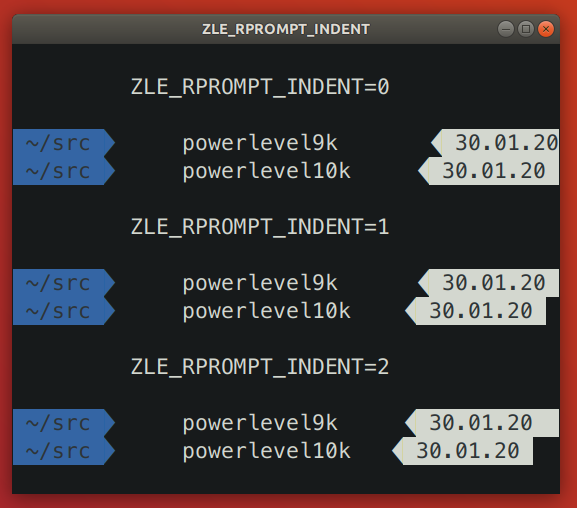
Powerlevel9k issue: powerlevel9k#1292.
It's been fixed in the development branch of Powerlevel9k but the fix hasn't yet made it to
master.
Add ZLE_RPROMPT_INDENT=0 to ~/.zshrc to get the same spacing on the right edge of prompt as in
Powerlevel9k.
Note: Several versions of Zsh have bugs that get triggered when you set ZLE_RPROMPT_INDENT=0.
Powerlevel10k can work around these bugs when using powerline prompt style. If you notice visual
artifacts in prompt, or wrong cursor position, try removing ZLE_RPROMPT_INDENT from ~/.zshrc.
Extra or missing spaces around icons
tl;dr: Add POWERLEVEL9K_LEGACY_ICON_SPACING=true to ~/.zshrc to get the same spacing around
icons as in Powerlevel9k.
Spacing around icons in Powerlevel9k is inconsistent.
![]()
This inconsistency is a constant source of annoyance, so it was fixed in Powerlevel10k. You can add
POWERLEVEL9K_LEGACY_ICON_SPACING=true to ~/.zshrc to get the same spacing around icons as in
Powerlevel9k.
Note: It's not a good idea to define POWERLEVEL9K_LEGACY_ICON_SPACING when using
p10k configure.
Weird things happen after typing source ~/.zshrc
It's almost always a bad idea to run source ~/.zshrc, whether you are using Powerlevel10k or not.
This command may result in random errors, misbehaving code and progressive slowdown of Zsh.
If you've made changes to ~/.zshrc or to files sourced by it, restart Zsh to apply them. The most
reliable way to do this is to type exit and then start a new Zsh session. You can also use
exec zsh. While not exactly equivalent to complete Zsh restart, this command is much more reliable
than source ~/.zshrc.
Transient prompt stops working after some time
See weird things happen after typing source ~/.zshrc.
Cannot make Powerlevel10k work with my plugin manager
If the installation instructions didn't work for you, try disabling your current theme (so that you end up with no theme) and then installing Powerlevel10k manually.
-
Disable the current theme in your framework / plugin manager.
-
oh-my-zsh: Open
~/.zshrcand remove the line that setsZSH_THEME. It might look like this:ZSH_THEME="powerlevel9k/powerlevel9k". - zplug: Open
~/.zshrcand remove thezplugcommand that refers to your current theme. For example, if you are currently using Powerlevel9k, look forzplug bhilburn/powerlevel9k, use:powerlevel9k.zsh-theme. - prezto: Open
~/.zpreztorcand putzstyle :prezto:module:prompt theme offin it. Remove any other command that setsthemesuch aszstyle :prezto:module:prompt theme powerlevel9k. -
antigen: Open
~/.zshrcand remove the line that setsantigen theme. It might look like this:antigen theme powerlevel9k/powerlevel9k. -
Install Powerlevel10k manually.
git clone --depth=1 https://github.com/romkatv/powerlevel10k.git ~/powerlevel10k
echo 'source ~/powerlevel10k/powerlevel10k.zsh-theme' >>~/.zshrc
This method of installation won't make anything slower or otherwise sub-par.
Directory is difficult to see in prompt when using Rainbow style
In Rainbow style the current working directory is shown with bright white text on blue background. The white is fixed and always looks the same but the appearance of "blue" is defined by your terminal color palette. If it's very light, it may be difficult to see white text on it.
There are several ways to fix this.
- Type
p10k configureand choose a more readable prompt style. - Change terminal color palette. Try Tango Dark or Solarized Dark, or change just the "blue" color.
- Change directory background and/or foreground color.
The parameters you are looking for are called
POWERLEVEL9K_DIR_BACKGROUND,POWERLEVEL9K_DIR_FOREGROUND,POWERLEVEL9K_DIR_SHORTENED_FOREGROUND,POWERLEVEL9K_DIR_ANCHOR_FOREGROUNDandPOWERLEVEL9K_DIR_ANCHOR_BOLD. You can find them in in~/.p10k.zsh.
Horrific mess when resizing terminal window
When you resize terminal window horizontally back and forth a few times, you might see this ugly picture.
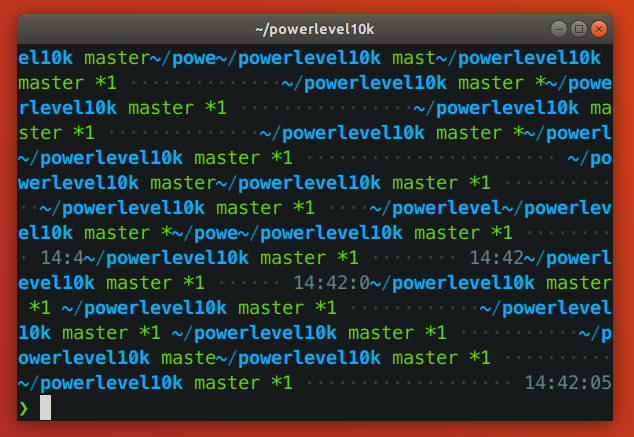
tl;dr: This is a bug in Zsh that isn't specific to Powerlevel10k. See mitigation.
Zsh bug
This issue is caused by a bug in Zsh that gets triggered when the vertical distance between the
start of the current prompt and the cursor (henceforth VD) changes when the terminal window is
resized. This bug is not specific to Powerlevel10k.
When a terminal window gets shrunk horizontally, there are two ways for a terminal to handle long lines that no longer fit: reflow or truncate.
Terminal content before shrinking:
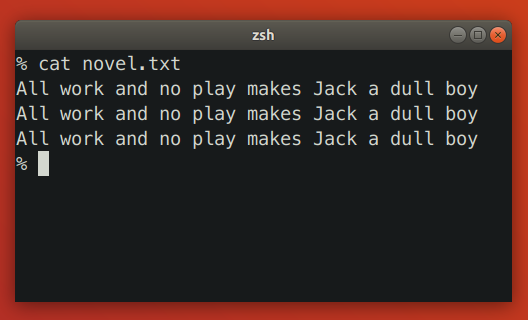
Terminal reflows text when shrinking:
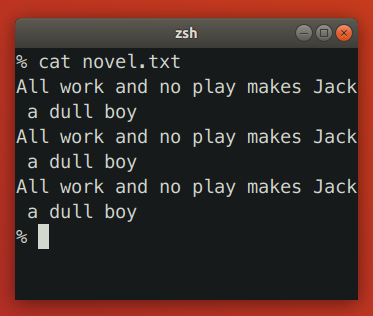
Terminal truncates text when shrinking:
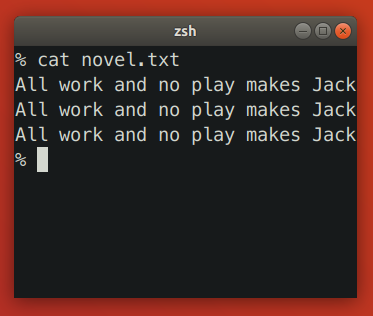
Reflowing strategy can change the height of terminal content. If such content happens to be between the start of the current prompt and the cursor, Zsh will print prompt on the wrong line. Truncation strategy never changes the height of terminal content, so it doesn't trigger this bug in Zsh.
Let's see how the bug plays out in slow motion. We'll start by launching zsh -df and pasting
the following code:
function pause() { read -s }
functions -M pause 0
reset
print -l {1..3}
setopt prompt_subst
PROMPT=$'${$((pause()))+}left>${(pl.$((COLUMNS-12))..-.)}<right\n> '
When PROMPT gets expanded, it calls pause to let us observe the state of the terminal. Here's
the initial state:
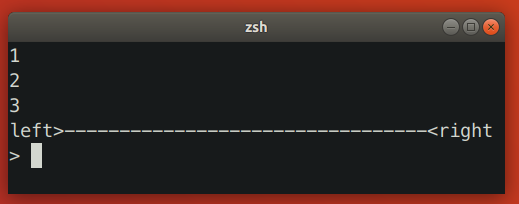
Zsh keeps track of the cursor position relative to the start of the current prompt. In this case it knows that the cursor is one line below. When we shrink the terminal window, it looks like this:
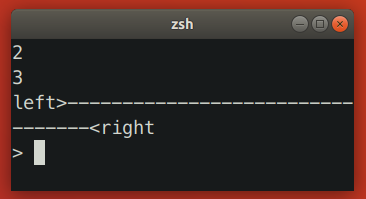
At this point the terminal sends SIGWINCH to Zsh to notify it about changes in the terminal
dimensions. Note that this signal is sent after the content of the terminal has been reflown.
When Zsh receives SIGWINCH, it attempts to erase the current prompt and print it anew. It goes to
the position where it thinks the current prompt is -- one line above the cursor (!) -- erases all
terminal content that follows and prints reexpanded prompt there. However, after resizing prompt is
no longer one line above the cursor. It's two lines above! Zsh ends up printing new prompt one line
too low.
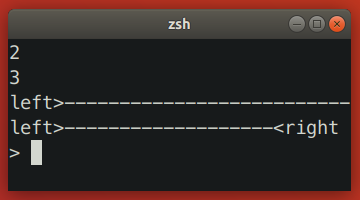
In this case we ended up with unwanted junk content because VD has increased. When you make
terminal window wider, VD can also decrease, which would result in the new prompt being printed
higher than intended, potentially erasing useful content in the process.
Here are a few more examples where shrinking terminal window increased VD.
Simple one-line left prompt with right prompt. No prompt_subst. Note that the cursor is below the
prompt line (hit ESC-ENTER to get it there).
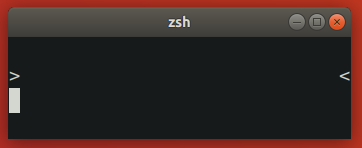
Simple one-line left prompt. No prompt_subst, no right prompt. Here VD is bound to increase
upon terminal shrinking due to the command line wrapping around.

Zsh patch
The bug described above has been partially fixed (only for some terminals) in this branch. The idea behind the fix is to use sc (save
cursor) terminal capability before printing prompt and rc (restore cursor) to move cursor back
to the original position when prompt needs to be refreshed.
The patch works only on terminals that reflow saved cursor position together with text when the terminal window is resized. The patch has no observable effect on terminals that don't reflow text on resize (both patched and unpatched Zsh behave correctly) and on terminals that reflow text but not saved cursor position (both patched and unpatched Zsh redraw prompt at the same incorrect position). In other words, the patch fixes the resizing issue on some terminals while keeping the behavior unchanged on others.
There are two alternative approaches to fixing the bug that may seem to work at first glance but in fact don't:
- Instead of
sc, useu7terminal capability to query the current cursor position and thencupto go back to it. This doesn't work because the absolute position of the start of the current prompt changes when text gets reflown. - Recompute
VDbased on new terminal dimensions before attempting to refresh prompt. This doesn't work because Zsh doesn't know whether terminal reflows text or truncates it. If Zsh could somehow know that the terminal reflows text, this approach still wouldn't work on terminals that continuously reflow text and rapid-fireSIGWINCHwhen the window is being resized. In such environment real terminal dimensions go out of sync with what Zsh thinks the dimensions are.
There is no ETA for the patch making its way into upstream Zsh. See discussion.
Mitigation
There are a few mitigation options for this issue.
- Apply the patch and rebuild Zsh from source. It won't help if you are using Alacritty, Kitty or some other terminal that reflows text on resize but doesn't reflow saved cursor position. On such terminals the patch will have no visible effect.
- Disable text reflowing on window resize in terminal settings. If your terminal doesn't have this setting, try a different terminal.
- Avoid long lines between the start of prompt and cursor.
- Disable ruler with
POWERLEVEL9K_SHOW_RULER=false. - Disable prompt connection with
POWERLEVEL9K_MULTILINE_FIRST_PROMPT_GAP_CHAR=' '. - Disable right frame with
POWERLEVEL9K_MULTILINE_FIRST_PROMPT_SUFFIX='',POWERLEVEL9K_MULTILINE_NEWLINE_PROMPT_SUFFIX=''andPOWERLEVEL9K_MULTILINE_LAST_PROMPT_SUFFIX=''. - Set
POWERLEVEL9K_RIGHT_PROMPT_ELEMENTS=(). Right prompt on the last prompt line will cause resizing issues only when the cursor is below it. This isn't very common, so you might want to keep some elements inPOWERLEVEL9K_RIGHT_PROMPT_ELEMENTSprovided that none of them are succeeded bynewline.
Icons cut off in Konsole
When using Konsole with a non-monospace font, icons may be cut off on the right side. Here "non-monospace" refers to any font with glyphs wider than a single column, or wider than two columns for glyphs designated as "wide" in the Unicode standard.

The last line on the screenshot shows a cut off Arch Linux logo.
There are several mitigation options for this issue.
- Use a different terminal. Konsole is the only terminal that exhibits this behavior.
- Use a monospace font.
- Manually add an extra space after the icon that gets cut off. For example, if the content of
os_iconprompt segment gets cut off, open~/.p10k.zsh, search forPOWERLEVEL9K_OS_ICON_CONTENT_EXPANSIONand change it as follows:
typeset -g POWERLEVEL9K_OS_ICON_CONTENT_EXPANSION='${P9K_CONTENT} ' # extra space at the end
- Use a different icon that is monospace. For example, if Arch Linux logo gets cut off, add
the following parameter to
~/.p10k.zsh:
typeset -g POWERLEVEL9K_LINUX_ARCH_ICON='Arch' # plain "Arch" in place of a logo
- Disable the display of the icon that gets cut off. For example, if the content of
os_iconprompt segment gets cut off, open~/.p10k.zshand removeos_iconfromPOWERLEVEL9K_LEFT_PROMPT_ELEMENTSandPOWERLEVEL9K_RIGHT_PROMPT_ELEMENTS.
Note: Non-monospace fonts are not officially supported by Konsole.
Arch Linux logo has a dot in the bottom right corner
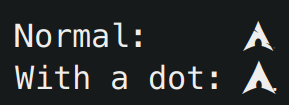
Some fonts have this incorrect dotted icon in bold typeface. There are two ways to fix this issue.
- Use a font with a correct Arch Linux logo in bold typeface. For example, the recommended Powerlevel10k font.
- Display the icon in regular (non-bold) typeface. To do this, open
~/.p10k.zsh, search forPOWERLEVEL9K_OS_ICON_CONTENT_EXPANSIONand remove%Bfrom its value.
typeset -g POWERLEVEL9K_OS_ICON_CONTENT_EXPANSION='${P9K_CONTENT}' # not bold